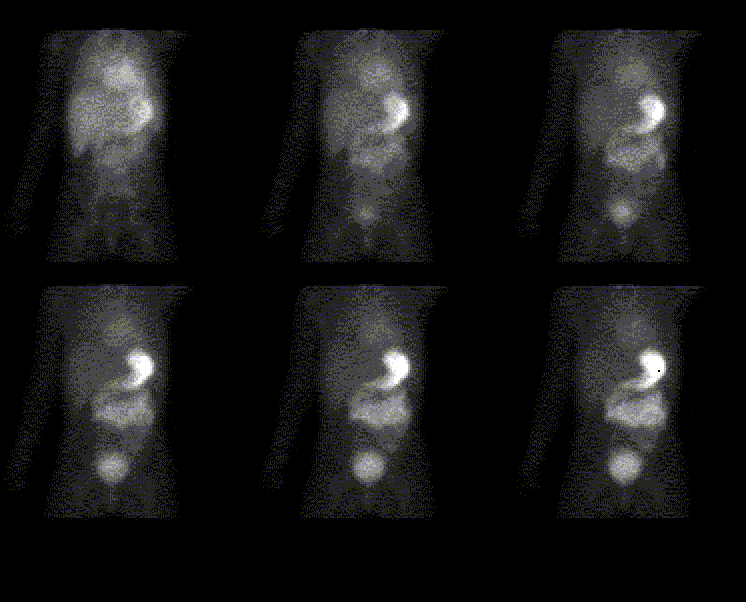Case Author(s): Marc Montella, M.D. and Barry A. Siegel, M.D. , 6/28/00 . Rating: #D3, #Q4
Diagnosis: Peutz-Jeghers Syndrome with Intermittent Intussusception
Brief history:
2-year-old girl with abdominal pain and melanotic stools
Images:

Sequential anterior 5-minute images (0-30 minutes post-injection) from a bowel scintigraphy (Meckel's diverticulum) study.
View main image(ms) in a separate image viewer
View second image(ms).
Delayed anterior, posterior, right lateral, and left lateral images from a bowel scintigraphy (Meckel's diverticulum) study.
View third image(ms).
Anterior and posterior post-void images from a bowel scintigraphy (Meckel's diverticulum) study.
View fourth image(gs).
Barium small bowel examination.
Full history/Diagnosis is available below
Diagnosis: Peutz-Jeghers Syndrome with Intermittent Intussusception
Full history:
2-year-old girl with a history of abdominal pain and melanotic stools, and possible diagnosis of Peutz-Jeghers syndrome. The patient had an upper and lower endoscopy, with multiple polyps seen.
An upper GI and small bowel barium study showed a nodular duodenum and several possible intraluminal filling abnormalities. The bowel imaging study was requested to evaluate for Meckel's diverticulum as a bleeding source.
Radiopharmaceutical:
1.7 mCi Tc-99m pertechnetate i.v.
Findings:
Sequential abdominal images show no focal uptake of Tc-99m pertechnetate to indicate a Meckel's diverticulum. However, there is
a large area of the proximal jejunum that shows increased Tc-99m pertechnetate uptake, which is occurring contemporaneously with uptake
in the stomach, increasing with time similar to that in the stomach, and remaining fixed in distribution over 1 hour.
Discussion:
Tc-99m pertechnetate imaging is used to detect ectopic gastric mucosa in Meckel's diverticula and enteric duplications.
Increased tracer uptake can also occur in vascular lesions (e.g., angioma or AVMs) and in inflammatory
lesions. Typically the uptake with these lesions appears earlier than does uptake in the stomach and decreases with time.
Activity in ectopic gastric mucosa usually appears concurrently with that in the stomach and increases with time.
Intussusception is another cause of increased activity, with uptake appearing early and persisting. The findings presumably reflect both
inflammatory changes and the intraluminal accumulation of the tracer proximal to the obstruction.
Peutz-Jeghers syndrome is an autosomal dominant condition characterized by multiple hamartomatous polyps in the small bowel, as well as in the stomach and colon. The polyps in patients with Peutz-Jeghers syndrome can serve as the lead points for intussusceptions, and cramping abdominal pain is a common manifestation.
Followup:
Review of the small bowel radiographs showed at least two and possibly three episodes of transient small bowel intussusception (note the typical coiled spring appearance in the left upper quadrant), which
occur and spontaneously reduce over the course of the small bowel follow-through. Although this can occasionally be seen as a variant of normal given this patient's strong family history, clinical findings are suspicious for at least two and possibly three Peutz-Jeghers polyps as leading edge foci for transient small bowel intussusception should be considered.
Differential Diagnosis List
A long jejunal duplication containing ectopic gastric mucosa could have a similar appearance.
A large region of involvement of bowel by regional enteritis (or an infectious enteritis) also should be considered even though the time course of Tc-99m pertechnetate uptake is not characteristic.
ACR Codes and Keywords:
References and General Discussion of Meckel's Scintigraphy (Anatomic field:Gasterointestinal System, Category:Neoplasm, Neoplastic-like condition)
Search for similar cases.
Edit this case
Add comments about this case
Return to the Teaching File home page.
Case number: ms004
Copyright by Wash U MO

